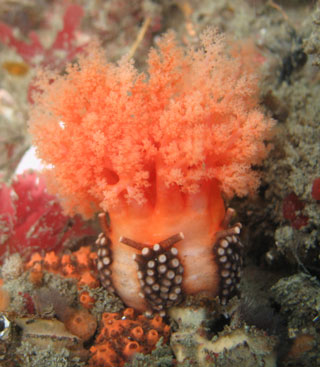Rocky marine habitats
ODFW marine scientists were recently very successful in securing funds for four research projects to expand understanding of Oregon's rocky marine habitats.
Funding came from the Oregon Ocean Science Trust, a group created by the 2013 Oregon Legislature to promote research and monitoring of Oregon's ocean and coastal resources.
Projects:
- Kelp communities in transition -
ODFW's shellfish program received $193,341 to document the ecological differences of rocky reef habitats with and without kelp beds. Commercial sea urchin divers and trained science divers will survey these areas and key species associated with kelp (sea urchins, abalones, and sea stars).
ODFW biologists will use the results to gauge the extent and rate of habitat changes in kelp beds and effects to these key species. Some Oregon kelp beds have declined and transitioned into urchin-barren areas while others have persisted relatively unchanged. Findings generated by the underwater surveys will also establish new baselines for management decision making about the future of Oregon's rock reef ecosystems.
The project timeline begins in March 2023 and runs through Sept. 2024.
- Seafloormapping - The Marine Habitat Program's proposed project to conduct high-resolution seafloor mapping received $181,000. State-of-the-art equipment will be leased and ODFW staff and a contracted technician will map the Rogue River Reef complex. This area is the last major unmapped nearshore rocky reef system in Oregon.
Located near Gold Beach, the reef supports the largest remaining kelp beds in Oregon, the largest and most robust commercial sea urchin harvest, and the largest Stellar sea lion rookery. The Rogue River Reef complex is also a likely potential sea otter reintroduction site. Mapping timing will be targeted to avoid strong summer winds.
A D V E R T I S E M E N T

A D V E R T I S E M E N T
- Juvenile fish dynamics - This project was granted $169,815 to genetically identify commercially and recreationally important juvenile fish (such as black, quillback or copper rockfish) recruiting into Oregon's nearshore environment. Oregon State University researchers will use 10 years of ODFW sampling data collected from Oregon's marine reserves.
 This information will be used to inform upcoming stock assessments about how juvenile fish grow and recruit into our nearshore fisheries. This is key to understanding how groundfish populations are replenished. The project also funds another year of monitoring efforts and helps evaluate the role of marine reserves as a refuge for these fishes. ODFW marine reserves staff is assisting with this project.
This information will be used to inform upcoming stock assessments about how juvenile fish grow and recruit into our nearshore fisheries. This is key to understanding how groundfish populations are replenished. The project also funds another year of monitoring efforts and helps evaluate the role of marine reserves as a refuge for these fishes. ODFW marine reserves staff is assisting with this project.
- Nearshore reef trophic modeling - ODFW and Oregon State University are partnering to create a food web (trophic) model to better understand the interactions and effects of management decisions on sea otter reintroduction, Dungeness crab, sea urchin, abalone, and kelp. The work builds on recent efforts to describe and model several aspects of nearshore habitat and species dynamics.
--Ryan Bannister| Post Date: 2023-02-13 10:12:26 | Last Update: 2023-02-13 18:50:19 |








 This information will be used to inform upcoming stock assessments about how juvenile fish grow and recruit into our nearshore fisheries. This is key to understanding how groundfish populations are replenished. The project also funds another year of monitoring efforts and helps evaluate the role of marine reserves as a refuge for these fishes. ODFW marine reserves staff is assisting with this project.
This information will be used to inform upcoming stock assessments about how juvenile fish grow and recruit into our nearshore fisheries. This is key to understanding how groundfish populations are replenished. The project also funds another year of monitoring efforts and helps evaluate the role of marine reserves as a refuge for these fishes. ODFW marine reserves staff is assisting with this project.